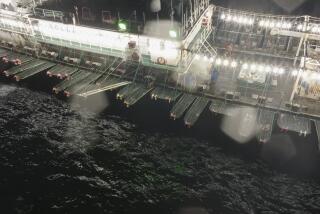Seasickness fears? Preparation can help make for a smooth cruise
David Adelman was worried. The Agoura Hills resident was about to embark on his second cruise. If it was anything like his first, he feared he would be laid low by the high seas.
On his first cruise in 1984, seasickness ruined his trip. Twenty-nine years later, he was giving cruising a second chance. Armed with medications, he nervously embarked in Seattle for an Alaskan cruise.
His fears proved groundless. Cruise No. 2 “was remarkably calm for me,” he said.
Those new to cruising often share Adelman’s concerns. But modern medicine and ever-improving ship designs, coupled with well-chosen itineraries, sailing dates and even cabin location can keep your focus on the fun and not on the fluttering of your stomach.
The cause of that discomfort may be body systems that are out of sync. Here’s how Dr. Glenn Hardesty of Texas Health Arlington Memorial Hospital explains seasickness: “There are two things that give you the understanding of where you are compared to everywhere else in the world, and that’s your visual reference and your semicircular canals” — tubes in the ear that detect motion.
“When they are in agreement, then everything is fine. When they are not in agreement, then you get the sense of nausea and vomiting.”
Those who are most susceptible to seasickness are children ages 2 through 12 and women (particularly those who are pregnant or menstruating), according to the national Centers for Disease Control and Prevention. Others who could have problems include migraine sufferers and those who take certain medications, such as some types of antidepressants and birth control pills.
Check with your doctor to see whether you could fall in those categories. And ask your doctor what medications might work for you. Hardesty suggests the Transderm Scop, a by-prescription patch that is placed behind the ear.
Adelman used the patch, and he ate ginger candy and wore acupressure wristbands.
But Adelman also had a smoother ride as he sailed to Alaska. On his first cruise, “the ship seemed to be going back and forth in relatively calm seas,” he said.
For this you can credit ship design, including stabilizers that “work in a similar manner to an aircraft wing, to dampen the motion of a ship,” said Bud Darr, senior vice president of technical and regulatory affairs for Cruise Lines International Assn., a trade organization.
Ships are also built with other features that help create a smooth ride, including bulbous bows, which help reduce drag as well as pitching.
Then too, most itineraries are designed to avoid choppy waters. Captains can reroute vessels to keep things calm.
As you consider a cruise, factor in where you’re going and when as part of your decision.
You’ll probably find a gentler ride on Pacific Coast Mexico trips from September to May, which is known as the region’s “dry” season. Caribbean sailings, which make up more than a third of the global deployment of cruise ships, are generally gentle outside of hurricane season.
Besides the itinerary, choice of cabin can also play a role. Cabins in the middle of the ship and on lower decks toward the water line tend to feel steadier.
You can also distract yourself by staying busy. Given the huge number of shipboard activities, that generally isn’t a problem.
Cruise Tip of the Week
How to combat seasickness
If you’re worried about seasickness, consider eating small meals and avoiding alcohol, which may contribute to an unsettled stomach.
More to Read
Sign up for The Wild
We’ll help you find the best places to hike, bike and run, as well as the perfect silent spots for meditation and yoga.
You may occasionally receive promotional content from the Los Angeles Times.






